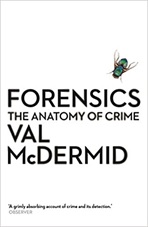The dead talk. To the right listener, they tell us all about themselves: where they came from, how they lived, how they died – and who killed them. Forensic scientists can unlock the mysteries of the past and help justice to be done using the messages left by a corpse, a crime scene or the faintest of human traces.
Forensics draws on interviews with top-level professionals, ground-breaking research and Val McDermid’s own experience to lay bare the secrets of this fascinating science. And, along the way, she wonders at how maggots collected from a corpse can help determine time of death, how a DNA trace a millionth the size of a grain of salt can be used to convict a killer and how a team of young Argentine scientists led by a maverick American anthropologist uncovered the victims of a genocide.
In her novels, McDermid has been solving complex crimes and confronting unimaginable evil for years. Now, she’s looking at the people who do it for real. It’s a journey that will take her to war zones, fire scenes and autopsy suites, and bring her into contact with extraordinary bravery and wickedness, as she traces the history of forensics from its earliest beginnings to the cutting-edge science of the modern day.
As a lover of crime fiction, I have a fascination with the forensic science that so often forms a part of those narratives. It might be the expert testimony given in court, the discovery of evidence placing someone at the scene, or the revelation of an unnatural cause of death that sets the investigation in motion, but forensic science often plays a pivotal role, irrespective of whether that’s the field that the protagonist works in themselves. I do, however, think that fiction – in its various forms – can make it seem more glamourous than it is, and yes, I’m predominantly looking at you, CSI!
We’re all fascinated by what forensic science can do. It makes for seductive crime fiction and thrilling TV series. But sometimes we get so caught up in the glamour of the story telling that we lose sight of the enormity of the crimes that confront investigators in the field.
In Forensics: The Anatomy of Crime, crime author Val McDermid explores twelve of the disciplines that make up forensic science, dedicating a chapter to each. From crime scene investigation and toxicology to facial reconstruction and finger printing, the reader is given a glimpse into the reality of these specialisms. In each chapter, McDermid explores the early instances of these techniques being utilised, and the ways in which they evolved over time to answer new challenges and as our science and technology have developed, allowing for refinement and improved accuracy. She also includes an interview with an expert in each field. This really brought it to life for me, and the insight into the lives of those who work in these fields and the challenges they face is fascinating.
Each chapter also includes cases in which forensic science has played a role in bringing a perpetrator to justice (or not, as the case may be). Some of these – not all – I remember seeing in the news. I think that seeing these cases and the forensic evidence that assisted in the investigation takes Forensics beyond the theory, really driving home that convictions are made through these disciplines. It’s not all entirely pleasant reading, and I now know far more maggots than I ever wanted to thanks to the chapter on entomology (did you know that they can eat and breathe simultaneously?). I think that this is quite sobering in some respects – it reminds the reader that forensic science isn’t just a clever plot device, but something that may help solve a murder or identify a perpetrator out in the real world.
Forensics: The Anatomy of Crime is a fascinating read and works as both an informative introduction to the science as well allowing a layperson such as myself more insight in a friendly and easily accessible manner. The science is brought to life, and I found the historical elements fascinating – seeing how the first tentative steps were taken, and how these disciplines have evolved over time. Recommended for anyone with an interest in this area.
